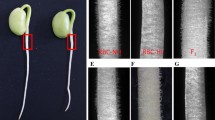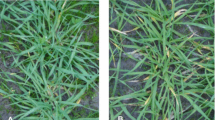Abstract
This paper reports a new barley mutant missing root hairs. The mutant was spontaneously discovered among the population of wild type (Pallas, a spring barley cultivar), producing normal, 0.8 mm long root hairs. We have called the mutant bald root barley (brb). Root anatomical studies confirmed the lack of root hairs on mutant roots. Amplified Fragment Length Polymorphism (AFLP) analyses of the genomes of the mutant and Pallas supported that the brb mutant has its genetic background in Pallas. The segregation ratio of selfed F2 plants, resulting from mutant and Pallas outcross, was 1:3 (−root hairs:+root hairs), suggesting a monogenic recessive mode of inheritance.
In rhizosphere studies, Pallas absorbed nearly two times more phosphorus (P) than the mutant. Most of available inorganic P in the root hair zone (0.8 mm) of Pallas was depleted, as indicated by the uniform P depletion profile near its roots. The acid phosphatase (Apase) activity near the roots of Pallas was higher and Pallas mobilised more organic P in the rhizosphere than the mutant. The higher Apase activity near Pallas roots also suggests a link between root hair formation and rhizosphere Apase activity. Hence, root hairs are important for increasing plant P uptake of inorganic as well as mobilisation of organic P in soils.
Laboratory, pot and field studies showed that barley cultivars with longer root hairs (1.10 mm), extracted more P from rhizosphere soil, absorbed more P in low-P field (Olsen P=14 mg P kg−1 soil), and produced more shoot biomass than shorter root hair cultivars (0.63 mm). Especially in low-P soil, the differences in root hair length and P uptake among the cultivars were significantly larger. Based on the results, the perspectives of genetic analysis of root hairs and their importance in P uptake and field performance of cereals are discussed.
Similar content being viewed by others
References
Asmar F, Gahoonia T S and Nielsen N E 1995 Barley genotypes differ in extra-cellular phosphatase activity and depletion of organic phosphorus from rhizosphere soil. Plant Soil 172, 117–122.
Avers C J 1958 Histochemical localization of enzyme activity in root epidermis of Phleum pratense. Am. J. Bot. 45, 609–613.
Bates T R and Lynch J P 2000 The efficiency of Arabidopsis thaliana (Brassicaceae) root hairs in phosphorus acquisition. Am. J. Bot. 87, 964–970.
Bieleski R L 1973 Phosphate pools, phosphate transport and phosphate availability. Annu. Rev. Plant Physiol. 24, 225–252.
Claassen N 1990 Nährstoffaufnahme höherer Pflanzen aus dem Boden. Ergebnis von Verfuegbarkeit und Aneignungvermögen. Severin Verlag, Göttingen. pp 327.
Cormack R G H 1962 Development of root hairs in angiosperms. Bot. Rev. 28, 446–464.
Dalal R 1977 Soil organic phosphorus. Adv. Agron. 29, 83–117.
Dinkelaker B and Marschner H 1992 In vivo demonstration of acid phosphatase in the rhizosphere of soil-grown plants. Plant Soil 144, 199–205.
Dittmer H J 1949 Root hair variations in plant species. Am. J. Bot. 36, 152–155.
Dosier L Wand Riopel J L 1977 Differential enzyme activity during trichoblast differentiation in Elodea canadensis. Am. J. Bot. 64, 1049–1056.
Föhse D, Claassen N and Jungk A 1991 Phosphorus efficiency of plants. II. Significance of root radius, root hairs and cation-anion balance for phosphorus influx in seven plant species. Plant Soil 132, 261–272.
Fussender A 1987 The longevity and activity of primary root of maize. Plant Soil 101, 257–265.
Gahoonia T S and Nielsen N E 1991 A method to study rhizosphere processes in thin soil layers of different proximity to roots. Plant Soil 135, 143–146.
Gahoonia T S and Nielsen N E 1992 The effect of root induced pH changes on the depletion of inorganic and organic phosphorus in the rhizosphere. Plant Soil 143, 185–191.
Gahoonia T S and Nielsen N E 1997 Variation in root hairs of barley cultivars doubled phosphorus uptake from soil. Euphytica 98, 177–182.
Gahoonia T S, Nielsen N E and Lyshede O B 1999 Phosphorus acquisition of cereal cultivars in the field at three levels of P fertilization. Plant Soil 211, 269–281.
Gilroy S and Jones D L 2000 Through form to function: root hair development and nutrient uptake. Trends Plant Sci. 5, 56–60.
Glass A D M, Shaff J E and Kochian L V 1992 Studies of uptake of nitrate in barley. 4. Electrophysiology. Plant Physiol. 99, 456–463.
Grierson C S, Roberts K, Feldmann K A and Dolan L 1997 The COW1 locus of Arabidopsis acts after RHD2, and in parallel with RHD3 and TIP1, to determine the shape, rate of elongation, and number of root hairs produced from each site of hair formation. Plant Physiol. 115, 981–990.
Hofer R-M 1996 Root hairs. In Plant roots: The Hidden Half. Eds. Y Waisel, A Eshel and U Kafkafi. pp 111–126. Marcel Dekker, Inc. New York.
Harris G 1998 An analysis of globel fertilizer application rates for major crops. Fertilizer Demand Meeting, Agro-Economics Committee, IFA Annual Conference, May 1998, Toronto, Canada.
Hinsinger P 1998 How do plant roots acquire mineral nutrients? Chemical processes involved in the rhizosphere. Adv. Agron. 64, 225–265.
Joshi P A, Stewart J M and Graham E T 1985 Localisation of β-glycerophosphatase activity in cotton fibre during differentiation. Protoplasma 125, 75–85.
Jungk A and Claassen N 1997 Ion diffusion in the soil-root system. Adv. Agron. 61, 53–110.
Kølster P, Munk L, Stølen O and Løhde J 1986 Near-Isogenic barley lines with genes for resistance to powdery mildew. Crop Sci. 26, 903–907.
Meharg A, Maurousset A L and Blatt M R 1994 Cable correction of membrane currents recorded from root hairs of Arabidopsis thaliana L. J. Exp. Bot. 45, 1–6.
Raghothama K G 1999 Phosphorus Acquisition. Annu. Rev. Plant Physiol. 50, 665–693.
Ridge WR 1996 Root hairs: Cell Biology and development. In Plant Roots: The Hidden Half. Eds. Y Waisel, A Eshel and U Kafkafi. pp 127–147. Marcel Dekker, Inc. New York.
Russell J R, Fuller J D, Macaulay, Harz B G, Jahoor A, Powell W and Waugh R 1997 Direct comparison of levels of genetic variation among barley accessions detected by RFLPs, AFLPs, SSRs and RAPDs. Theor. Appl. Genet. 95, 714–722.
SAS Institute Inc. 1989 SAS/STAT. User Guide. Version 5. SAS Institute Inc., Cary, NC, USA.
Saghai-Maroof M A, Soliman K K, Jorgensen R A and Allard R W 1984 Ribosome Space length polymorphisms in Barley. Mandelian inheritence, chromosome location and population dynamics. Proc. Natl. Acad. Sci. USA 81, 8014–8018.
Sattelmacher B, Heinecke I and Müling K H 1993 Influence of minerals on cytoplasmic streaming in root hairs of intact wheat seedlings. Plant Soil 155/156, 107–110.
Schiefelbein JW and Somerville C 1990 Genetic control of root hair development in Arabidopsis thaliana. Plant Cell 2, 235–243.
Smith R D, Wilson J E, Walker J C and Baskin T I 1994 Protein- phosphatase inhibitors block root hair growth and alter cortical cell shape of Arabidopsis roots. Planta 194, 516–524.
Spurr A R 1969 A low-viscosity epoxy resin embedding medium for electron microscopy. J. Ultrastruct. Res. 26, 31–43.
Schweiger P F, Robson A D and Barrow N J 1995 Root hair length determines the beneficial effect of a Glomus species on shoot growth of some pasture species. New Phytol. 131, 247–254.
Tanimoto M, Roberts K and Dolan L 1995 Ethylene is a positive regulator of root hair development in Arabidopsis thaliana. Plant J. 8, 943–948.
Wada T, Tachibana T, Shimura Y and Okada K 1997 Epidermal cell differentiation in Arabidopsis determined by a myb Homolog, CPC. Science 277, 1113–1115.
Wen T J and Schnable P S 1994 Analyses of mutants of three genes that influence root hair development in Zea mays (Graminae) suggest that root hairs are dispensable. Am. J. Bot. 81, 833–842.
Author information
Authors and Affiliations
Rights and permissions
About this article
Cite this article
Gahoonia, T.S., Nielsen, N.E., Joshi, P.A. et al. A root hairless barley mutant for elucidating genetic of root hairs and phosphorus uptake. Plant and Soil 235, 211–219 (2001). https://doi.org/10.1023/A:1011993322286
Issue Date:
DOI: https://doi.org/10.1023/A:1011993322286




